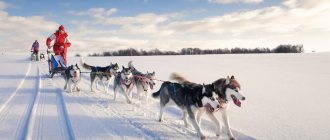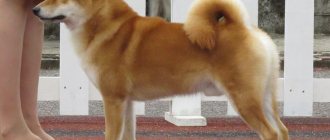You love your dog with a devotion that rivals your feelings for your loved one. But does she feel the same way about you? When your dog looks at you with adoration, is it true canine devotion or is he just wondering when you'll give him his next meal? If you've ever wondered if all those dog kisses and cuddles are just for the sake of tastier food, don't worry. The feeling between you and your pet is truly mutual, and the dog's devotion is extremely real.
BULLMASTIF.
0
14 2 12
Liked
12
The well-known “watchman” and faithful companion of man, the bullmastiff, opens the ranking of the most loyal dog breeds. It is worth noting that the dog, affectionate and gentle towards its owner, can be wary of strangers. The independent breed originated in 1924 in Great Britain. Initially, these were irreplaceable assistants to hunters, capable of finding and detaining prey. Strong and robust, the animals retained the features of their ancestors - bulldogs and mastiffs. The standards attribute to them a height at the withers of up to 69 cm and a weight of up to 59 kg. In their appearance, they are noted for their massive skull, strong teeth and widely spaced eyes. The ears are set high. The neck is muscular, just like the body. The pet has its own opinion on any matter and is considered quite stubborn. However, the pet prefers a partnership with the owner to open confrontation. In addition, he gets along well with children and other pets. Guard dogs adapt well to apartment life.
Show 0 comments / Write a comment
What do you think about this?
New ones first
First the best First the old
show all
Show more (from _)
Kostya
This story took place in the Russian city of Tolyatti. People constantly saw a dog sitting on the side of a busy road all day long, seemingly waiting for someone. Local residents tried more than once to find the dog a new home, but the dog always returned to the place from where it was taken. It later turned out that the animal’s past hides a very tragic story.
Until his death, Kostya sat on the side of the road and waited for his owners.
It turned out that the dog was sitting at the scene of a terrible accident that claimed the lives of two people. The girl died immediately during an accident, and her father died from his injuries a little later, in the hospital. Only their dog survived. From then until his death, he sat on the side of the road and waited for his owners, who would never return. For his devotion, the residents of Tolyatti called the dog “Faithful” or simply “Kostya” (“Konstantin” is translated from Greek as “Constant” and “Faithful”).
Kostya kept his watch for seven whole years. Local residents were very sad when the dog died. And a little later, the city erected a monument to Kostya and called it “Loyalty.” Since then, the monument to the devoted animal has become a place of pilgrimage for newlyweds. Brides and grooms of Togliatti touch the tip of the nose of the bronze dog - it is believed that after performing this simple ritual, the marriage bond will be as strong as Kostya was faithful to his family.
PITBULL.
0
22 6 16
Liked
16
The line above is the pit bull. The second name of the service breed is the American Pit Bull Terrier. The pets owe their appearance to their distant ancestors - English bulldogs and terriers. The country of origin of the species is considered to be the USA. In these dogs, the breeders managed to successfully combine fearlessness, phenomenal speed, and athleticism. It is worth noting that until 1835, dogs fought with each other in battles, and later they were used in drug trafficking. The problem was solved only by tightening the laws. Compact size, smooth fur, and the absence of excessive salivation make keeping brutal pets in an apartment not burdensome. Affectionate and gentle, the animal gets along well with any family members. He is so devoted to his master that he will give his life for him without hesitation. Perhaps the pit bull is the ideal bodyguard.
Show 0 comments / Write a comment
What do you think about this?
New ones first
First the best First the old
show all
Show more (from _)
ST BERNARD.
0
23 1 22
Liked
22
Saint Bernards rank twelfth on our list of the most loyal dog breeds. Large pets with red and white fur are considered excellent “rescuers” due to their character. The desire to please the owner in every possible way and friendly disposition make their training and keeping them at home almost problem-free. For families with small children, “tailed educators” are a godsend. St. Bernards were bred in the Swiss Alps in the mid-17th century. Their ancestors are considered to be Tibetan Great Danes. Animals with thick skins were excellent at navigating the mountains and easily found people under snow rubble. It is worth noting that peace-loving pets are distinguished by an affectionate attitude towards any family member. In addition, plush creatures do not create unnecessary noise due to their calm disposition.
Show 0 comments / Write a comment
What do you think about this?
New ones first
First the best First the old
show all
Show more (from _)
DAX.
0
14 3 11
Liked
11
On the eleventh line is the dachshund. Despite their small size, funny pets are characterized by a bright personality, strong character, incredible courage, and also a high level of intelligence. It is believed that an independent variety appeared in the 16th century. The ancestors of modern individuals were German short-legged Bracket hounds. From the latter, dachshunds inherited small limbs. This helped the little ones to easily maneuver in narrow holes. Thus, the tailed animals successfully coped with badger raids on farmland. The bark of the dachshund is surprisingly powerful and loud. According to the German Tekel Club, these dogs not only have a strong character, but also a heightened sense of self-esteem.
Show 0 comments / Write a comment
What do you think about this?
New ones first
First the best First the old
show all
Show more (from _)
Rescue dog from Altai
A year ago, a story happened in Altai that shocked the whole of Russia. A mother left her two-year-old child on the veranda of the house in the bitter cold. The baby was doomed to death, but survived only because a dog perched next to him and warmed the child with its warmth until the rescuers arrived. About how a dog saved a child abandoned by his mother on the street from death
, we have already written in more detail.
Did you like the article? Then support us, click
:
Sources:
https://www.bolshoyvopros.ru/questions/101964-pochemu-sobaka-tak-predana-cheloveku-i-nikogda-ego-ne-predast.html https://www.belanta.vet/vet-blog/pochemu -sobaki-predany/ https://kulturologia.ru/blogs/100618/39272/
ROTTWEILER.
0
12 4 8
Liked
8
A stately, powerful, strong dog was originally bred to perform security functions, so he is a wonderful protector. Thanks to its intelligence, the dog perfectly remembers commands, and having high intelligence, it is able to make decisions on its own. However, the breed is very stubborn, and when training, the owner will have to be as persistent as possible in order to achieve results. Rottweilers are one of the most loyal breeds with strong nerves and a kind character. The dog will become an excellent, loyal friend, but you must reciprocate his feelings, and most importantly, raise him correctly, because due to his strong and independent character, a poorly trained dog can cause a lot of trouble.
Show 0 comments / Write a comment
What do you think about this?
New ones first
First the best First the old
show all
Show more (from _)
SHELTIE.
0
14 2 12
Liked
12
The breed boasts a rich fluffy coat, good memory, an excellent sense of smell and inexhaustible energy. Very sociable and active, but at the same time calm, loves attention and children. It is easy to train thanks to its attentiveness and intelligence. Despite its relatively small size and cute, fluffy appearance, a dog cannot be made into a toy. She needs regular long walks. It is not advisable to fulfill any whims of the dog, just as it is not advisable to leave him alone for a long time, the golden mean is important here. Although this dog is a completely useless guard, he is a wonderful and obedient friend. And an apartment is ideal living conditions for him.
Show 0 comments / Write a comment
What do you think about this?
New ones first
First the best First the old
show all
Show more (from _)
Lapdog of Mary Stuart, Queen of Scots and France
Mary Stuart, Queen of Scots, had an adventurous life. She became Queen of Scotland in infancy. A few years later, she managed to spend some time as Queen of France, lost the French crown, almost lost her life and was forced to return to Scotland. Later, she had to flee to England, where, after numerous intrigues and conspiracies, Mary was beheaded by order of the queen, who saw her cousin as a threat to the English throne.
Mary Stuart's life was characterized by inconstancy and changeability, but there was something constant in it - a flock of lapdogs given to her by French subjects in 1559. In the last years of her life, while imprisoned in Sheffield Castle, Maria talked to her dogs so as not to go crazy from loneliness.
They say that when Mary's head rolled off the block, a tiny dog crawled out from under the executed woman's dress.
And so the trial of Mary Stuart came to an end and Elizabeth I signed the death warrant for her sister, accusing her of plotting to seize the throne. The condemned woman was led to the scaffold, but at first no one noticed that the woman sentenced to death was not alone. Under the lush robe of the unlucky queen was a small lapdog, one of Mary Stuart's favorites.
When Maria's head rolled off the block, a tiny dog crawled out from under the executed woman's dress. Covered in fresh blood, the animal lay down next to the body of its dead owner. They say it took a lot of work to drag the dog away. The poor animal later died of exhaustion.
DOBERMAN.
0
20 3 17
Liked
17
This is a German breed, medium in size with a muscular and strong build. The fur is short and soft, and the ears are funny upturned. Dobermans are loyal, devoted dogs, smart, kind, hardy and fast. Despite their good nature, they are excellent protectors for their owner and excellent watchmen. Always vigilant and observant. From puppyhood, you need to pay special attention to training your pet, and it is best to walk an adult on a leash. Despite its intelligence and high learning ability, raising a Doberman is not an easy task. This dog needs a strong and firm leader, otherwise the dog’s stubbornness will not be dealt with, and it may get out of control.
Show 0 comments / Write a comment
What do you think about this?
New ones first
First the best First the old
show all
Show more (from _)
Dog Balto from Alaska
Few people know that the cartoon dog Balto is not a fictional character, but a real dog who performed a heroic feat and saved dozens of lives. This sled husky has always been considered clumsy and slow, but it was he who showed strength of character at a time when the lives of children were at stake.
In Alaska in 1925, there was an outbreak of diphtheria; it was impossible to deliver the serum by air due to stormy weather, then it was decided to go for it with dogs.
The team in which Balto was harnessed covered a distance of 1000 km, despite heavy winds and snowfall. The smart dog managed to avoid many dangers along the way and reached the finish line, despite physical fatigue. The children were saved, and the real story of the sled dog that saved the city from an epidemic at the beginning of the twentieth century
, became a legend.
COLLIE.
0
21 1 20
Liked
20
Externally, the dog resembles a Sheltie (sixth place in our ranking), but its dimensions are much larger. And while the Sheltie is a very energetic, active dog, the Collie is emotionally restrained and calm. The Scottish Shepherd is distinguished by intelligence, kindness and loyalty, gets along well with children, is sensitive to the mood of its owner and easily adapts to his lifestyle. All these qualities lead to the fact that separation from its breadwinner is very difficult for the dog. When getting a collie, you need to be prepared for constant walks: leisurely and measured or intense and active, it doesn’t matter. You can safely have other pets with this friendly breed; it gets along well even with cats.
Show 0 comments / Write a comment
What do you think about this?
New ones first
First the best First the old
show all
Show more (from _)
How to measure a dog's loyalty
A dog's loyalty is something we don't usually question. However, devotion comes in different forms. One dog is called a sellout because it is ready to beg for sausage from every guest in the house, another is admired because it died on the grave of its owner. Is it possible to objectively define and measure a dog's loyalty?
Monuments to dog fidelity
Usually people romanticize the affection of a dog, admiring dogs like Hachiko, who ran every day to meet his owner at the train station. The dog continued to do this for many years after the death of his owner. Monuments to dog fidelity were created based on similar themes, which were erected at different times in Russia, Poland, Japan, Italy, Scotland and the USA. But most dogs are able to become attached to a new owner quite quickly. In the study, it was enough for people to take a shelter dog for a 10-minute walk three days in a row [4]. After this, in an experiment testing attachment, she clearly preferred the person who walked with her.
What behavior of a dog, or more precisely, what kind of attachment is normal and desirable for a person?
The father of modern ethology, Konrad Lorenz, in his books describes different kinds of affections: a dachshund who loved everyone; a German shepherd who became unbearable in his absence and had to be constantly kept on a chain; and a hound who “fell in love” with him suddenly, without any support from him. Lorenz describes a certain sensitive period when a dog begins to look for an owner. He believes that for some breeds this period is long and comes late, while for others only a few days are enough, during which they are able to choose their “object of worship.”
Konrad Lorenz is known primarily for his formulation of the concept of imprinting. The point is that in an animal’s childhood there are periods when its memory is especially sharp. Lorenz conducted imprinting studies on goslings. The chicks, hatching from the egg, remembered the first thing they saw, for example, a boot. They considered the boot their mother and followed it everywhere. As the geese grew older, they could develop disturbances in sexual behavior. They perceived the boot as their potential sexual partner and directed their courtship towards him. It turns out that imprinting has irreversible consequences for all subsequent behavior of the animal.
Ethology, psychology and ethology again
In the 50s of the twentieth century, the famous English child psychologist J. Bowlby formulated the concept of a child’s attachment to his mother.
He took Konrad Lorenz's theory of imprinting as a basis and transferred it to the field of child psychology. Unlike goslings, children are born immature; they cannot follow their mother and cannot feed on their own. Therefore, Bowlby suggested, the formation of attachment, although akin to imprinting, occurs within a few months of life. In line with the concept of attachment, psychologist Mary Ainsworth developed the “strange situation” test [2], which can be used to study the child’s attitude towards his mother. Over the past half century, psychology has experienced a real boom in scientific research on attachment, about a thousand of which have been conducted. Thanks to them, we can now speak quite accurately about certain periods of a child’s early development and about the influence that various events of infancy have on his character in the future.
A test for studying attachment, developed by psychologists, turned out to be quite convenient for determining a dog’s attachment to a person. The idea of “returning” the concept of attachment to ethology dawned on Hungarian scientists in 1998. They completed four papers on this topic [4, 5, 9, 10]. Four studies were also conducted by Italian scientists [3, 6, 7, 8].
Attachment testing
We began experiments on attachment in 2005 at the Faculty of Biology of Moscow State University under the guidance of Dr. E.P. Kruchenkova. The test consists of seven episodes following each other. It looks like a mini-performance for a dog: first, the owner introduces it to an unfamiliar room, and it looks around. There are toys on the floor and a bowl of water. Three minutes later, a woman, unfamiliar to the dog, comes in. She talks to the owner, then invites the dog to play. Then, after another three minutes, the owner leaves. If the dog is worried, the “stranger” tries to distract it and offer to play. Then the owner returns, and the “stranger” leaves. After another three minutes, the owner leaves the room and the dog is left alone. If she is very excited, barks, scratches the door, then this episode is shortened, but if the dog behaves relatively calmly, then it also lasts three minutes. After him, a “stranger” enters the room, and three minutes later the owner enters, and the “stranger” leaves.
Over the course of 21 minutes, the dog experiences separation from its owner and a meeting with a stranger twice. Having finished testing, we view the results on video, calculate the frequency and duration of various behavioral elements, for example, how much time the dog spent looking around the room in the first episode, how long in the second, etc. .d. How long did she play with the owner, and how long did she play with the “stranger”. Each dog is an individual, each brought something of its own to the test. For example, one Basenji, remaining alone in a room or with a “stranger,” climbed onto the mistress’s chair and there waited for the “object of affection” to return. Another dog, a five-month-old Great Dane puppy, was running around the room with a leash in its mouth. And the Malinois managed to open the door lock and get out of the room. The experiment, of course, was disrupted, but the quick-witted dog was rewarded with universal admiration.
With all the diversity of dog characters, we also noticed common features in their behavior. For example, 20–30 seconds after the owner left the room, each dog approached the chair on which the owner was sitting, sniffed it and the things left there, after which they usually returned to the door again, whined, scratched, or simply waited quietly. In experiments by psychologists, children at these stages of the test also approached the chair on which their mother was sitting, and then returned to the door. Do you remember the advice that experienced breeders give to puppy buyers: “Get a bedding or toy that smells like home to the puppy so that it will be easier for him to get used to his buyers’ new home”? Things that smell like a loved one seem to represent it in its absence.
Ours - someone else's
In all eight studies conducted, as in ours, dogs played less with strangers than with their owners, were much more happy with the owner when he entered the room, and whined, barked and scratched the door when he left. Each change in the situation was also reflected in the heart rate [6]. Perhaps the exceptional canine loyalty to which monuments are erected is more related to the rejection of strangers due to some negative experience in the past. As a result, the normal preference for the owner of dogs grew into the inability to form a new attachment.
Wolves behave differently in this regard than dogs [9]. Hungarian scientists raised wolf cubs from 3 to 5 days of age, spending 20 to 24 hours a day with them. When the wolf cubs were four months old, their attachment was tested. It turned out that they interact with strangers as much as with their owners, and do not express concern, remaining in the room only with the “stranger”. Puppies raised in the same way also turned out to be extremely sociable, but as soon as the owner walked out the door, their interest in the stranger disappeared, and they began to demand the owner's return.
"Security Base"
E. Prato-Previd and her colleagues, relying on the words of Mary Ainsworth [1], considered that only the relationship of a dog to its owner in which it perceives him as a “base of security” can be called affection. This means that the dog’s owner is the center of the universe; he, like a ball on an elastic band, pushes off from him, gets acquainted with the environment and immediately flies to his “base”. When the owner is present, the dog is active, mobile, and explores its surroundings. When the owner is not around, the dog is mostly passive, and if he does not try to get to him, then he stands or lies, waiting for his return.
In an experiment conducted by Italian scientists, dogs examined the furnishings of the room less and less every minute; it became familiar to them [7]. But these were adult dogs who were used to waiting for their owner. We completely replicated the experimental design of E. Prato-Previde and her colleagues, but tested only young dogs that had not reached sexual maturity.
In our study, the behavior of puppies was found to be more similar to that of one-year-old human children than to that of adult dogs in terms of affection signs. Puppies, like children, as soon as the “object of affection” left the door, they stopped looking around the room and becoming interested in toys, regardless of whether a stranger was in the room or not. When the owner, in the case of dogs, or the mother, in the case of children, returned, the puppies and children began to become interested in their surroundings again.
Italian and Hungarian scientists compared the results of tests on dogs used as guides for the blind and ordinary pets. It turned out that the dog’s behavior in the “strange situation” test is not related to the quality of its work as a guide for a blind person [5]. Small differences in fearfulness and activity are explained by the dog’s training to a particular style of interaction with a person, but all attachment traits are characteristic of both guide dogs for the blind and pets [3].
It is important for a practicing dog handler to understand how a dog’s affection manifests itself in everyday life. The dog turns out to be more active and bolder in the presence of the owner. If two male dogs sniffed each other and stopped indecisively, then the approach of the owner will give his pet self-confidence and often provoke a fight. In the absence of the owner, dogs actually cause less trouble for the groomer and veterinarian, as they are more likely to display the passive behavior that is expected of them. If you scold a timid dog because it disrupts the demonstration of restraint on command and does not want to stay in place when the owner moves away, then, feeling anxious, it will jump up again and try to get closer to the “safety base”.
Only about 300 dogs have been tested so far. Science does not yet know how attachments are formed in stray dogs, how many times a dog can become attached to a new owner and how quickly, and how this affects its mental well-being. We have to find out all this.
Literature:
1.Ainsworth M. Attachments beyond infancy // Am. Psychol. 1989. No. 44. P. 709–716.
2.Ainsworth M., Wittig B. Attachment and exploratory behavior of one-year olds and in a strange situation // Determinants of infant behavior / Ed. B. M. Foss. 1969. Vol. 4. P. 111–136.
3.Fallani G., Previde EP, Valsecchi P. Do disrupted early attachments affect the relationship between guide dogs and blind owners? //Appl. An. Behav. Sci. 2006. Vol. 100. Issue 3–4. P. 241–257.
4.Gacsi M., Topal J., Miklosi A., Doka A., Csanyi V. Attachment behavior of adult dogs (Canis familiaris) living at rescue centers: forming new bonds // Journal of Comparative Psychology. 2001. Vol. 115. R. 423–431.
5.Naderi Sz., Miklosi A., Doka A., Csanyi V. Does dog-human attachment affect their inter-specific cooperation? // Acto Biologics Hiingarica. 2002. Vol. 53(4). P. 537–550.
6. Palestrini C., Prato Previde E., Spiezio C., Verga M. Heart rate and behavioral responses of dogs in the Ainsworth's Strange Situation: A pilot study //Animal Behavior Science. 2005. Vol. 94. P. 75–88.
7.Prato-Previde E., Custance DM, Spiezio C., Sabatini F. Is the dog–human relationship an attachment bond? An observational study using Ainsworth's strange situation // Behavior. 2003. Vol. 140. P. 225–254.
8.Prato-Previde E., Fallani G., Valsecchi P. Gender Differences in Owners Interacting with Pet Dogs: An Observational Study // Ethology. 2006. Vol. 112. P. 64–73.
9.Topal J., Gacsi M., Miklosi A., Viranyi Z., Kubinyi E., Csanyi V. Attachment to humans: a comparative study on hand-reared wolves and differently socialized dog puppies // Animal Behaviour. 2005. Vol. 70. P. 1367–1375.
10. Topal J., Miklosi A., Doka A., Csanyi V. Attachment behavior in dogs (Canis familiaris): a new application of Ainsworth’s (1969) strange situation test // Journal of Comparative Psychology. 1998. Vol. 112. P. 219–229.











